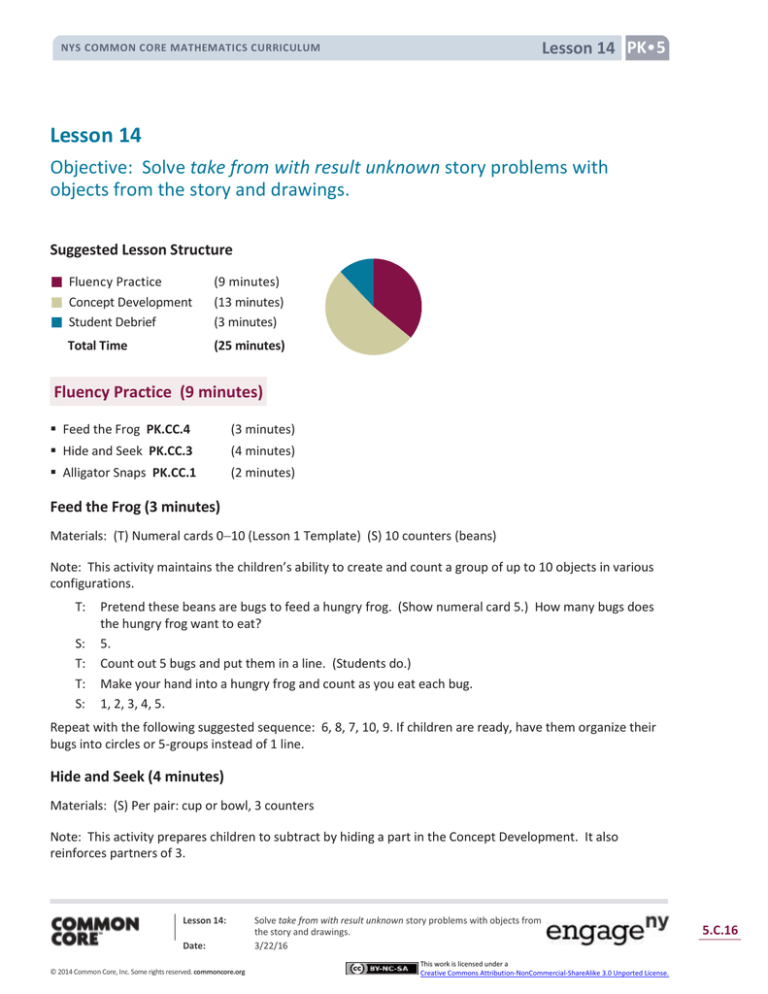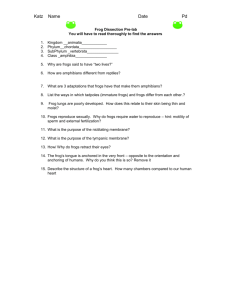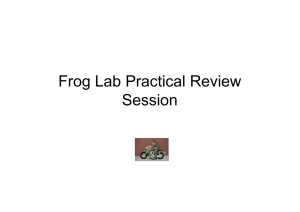
Lesson 14 PK•5
NYS COMMON CORE MATHEMATICS CURRICULUM
Lesson 14
Objective: Solve take from with result unknown story problems with
objects from the story and drawings.
Suggested Lesson Structure
Fluency Practice
Concept Development
Student Debrief
Total Time
(9 minutes)
(13 minutes)
(3 minutes)
(25 minutes)
Fluency Practice (9 minutes)
Feed the Frog PK.CC.4
(3 minutes)
Hide and Seek PK.CC.3
(4 minutes)
Alligator Snaps PK.CC.1
(2 minutes)
Feed the Frog (3 minutes)
Materials: (T) Numeral cards 010 (Lesson 1 Template) (S) 10 counters (beans)
Note: This activity maintains the children’s ability to create and count a group of up to 10 objects in various
configurations.
T:
S:
T:
T:
S:
Pretend these beans are bugs to feed a hungry frog. (Show numeral card 5.) How many bugs does
the hungry frog want to eat?
5.
Count out 5 bugs and put them in a line. (Students do.)
Make your hand into a hungry frog and count as you eat each bug.
1, 2, 3, 4, 5.
Repeat with the following suggested sequence: 6, 8, 7, 10, 9. If children are ready, have them organize their
bugs into circles or 5-groups instead of 1 line.
Hide and Seek (4 minutes)
Materials: (S) Per pair: cup or bowl, 3 counters
Note: This activity prepares children to subtract by hiding a part in the Concept Development. It also
reinforces partners of 3.
Lesson 14:
Date:
© 2014 Common Core, Inc. Some rights reserved. commoncore.org
Solve take from with result unknown story problems with objects from
the story and drawings.
3/22/16
This work is licensed under a
Creative Commons Attribution-NonCommercial-ShareAlike 3.0 Unported License.
5.C.16
Lesson 14 PK•5
NYS COMMON CORE MATHEMATICS CURRICULUM
Pair students and give each pair a cup or bowl with counters. Make one partner the hider and the other
partner the guesser.
T:
S:
T:
T:
S:
T:
S:
T:
How many bears are in your cup?
3.
Guessers, close your eyes. Hiders, hide this many bears under your cup. (Show 2 fingers.)
Guessers, open your eyes. How many bears are not hiding?
1.
Guess how many bears are hiding.
I don’t know. 2.
Hiders, show how many bears are hiding.
Have students switch roles and repeat, this time hiding 1 bear. Give partners a chance to play independently
when they are ready.
Alligator Snaps (2 minutes)
Note: This activity targets one of the core fluencies for Pre-K students, rote counting to 20. Varying the stop
number challenges students to remain attentive to the counting sequence.
T:
It’s Allie Alligator’s lunchtime again. Let’s pretend we’re Allie catching fish for lunch. She wants 18
fish today. Let’s count to 18 the Say Ten Way.
Demonstrate arms open wide, one above the other, mimicking alligator jaws. Tell students that Allie is still
hungry, and count once more to 19 the regular way.
Concept Development (13 minutes)
Part 1: Concept Introduction
Materials: (T) 5 frogs picture (Template) (S) 5 frogs picture (Template) inserted in personal white board
Note: This Concept Development was inspired by the popular children’s song, "5 Green and Speckled Frogs."
1. Display 5 frogs picture. Say, "Listen to my new
subtraction story: Five green and speckled frogs sat on
a speckled log. One jumped into a pool where it was
nice and cool."
2. Say, "Tell me what happens first in the story. Does our
picture show 5 frogs?" Have children count and
confirm.
3. Say, "Tell me what happens next." Cross off 1 frog
while students do the same.
4. Ask, "Who knows what the question might be?" Listen to different
thoughts. Reiterate, "How many frogs are left?" Students repeat and count the remaining frogs.
5–1=4
Lesson 14:
Date:
© 2014 Common Core, Inc. Some rights reserved. commoncore.org
Solve take from with result unknown story problems with objects from
the story and drawings.
3/22/16
This work is licensed under a
Creative Commons Attribution-NonCommercial-ShareAlike 3.0 Unported License.
5.C.17
Lesson 14 PK•5
NYS COMMON CORE MATHEMATICS CURRICULUM
5. Say the number statement together, "5 frogs take way 1 frog is 4 frogs." Write the number
sentence (5 – 1 = 4) saying, "5 take away 1 equals 4," and read it as a group.
6. Ask, "What does the 5 in our number sentence tell us about?" Repeat the question for the
numerals 1 and 4.
7. Say, "Let’s draw a subtraction story about the delicious bugs the frogs like to eat. Turn to the
blank side of your board." Say: "Four bugs were on a log. A frog gobbled up 2 of them. How
many bugs were still on the log?" Ask volunteers to retell each part of the story, pause to draw,
and check with a neighbor. Encourage quick, simple drawings.
8. Ask, "Who can remember the question?" Then, say the number sentence as a class, repeating
Steps 56.
Part 2: Practice
Materials: (S) Per student: 5 frogs picture (Template) and numeral writing rectangle (Lesson 5 Template 2)
inserted in personal white board
Pair students and send them to tables.
1. Say, "Five green and speckled frogs sat on a
NOTES ON
speckled log. Two jumped into a pool where it was
MULTIPLE MEANS
nice and cool. How many were sitting on the log?"
OF ACTION AND
2. Instruct partners to retell the story with the
EXPRESSION:
question. They cross off 2 frogs and check to make
Reread the problem one last time to
sure the picture matches the story.
allow students to check their work.
3. Write the number sentence on the board (5 – 2 = 3)
Prompt students to circle the part of
while saying together, "5 take away 2 equals 3."
their drawing that answers the
4. Say, "Under your picture, draw my new subtraction
question. This provides students a
chance to analyze their work and
story with bugs: Four little bugs were crawling on a
correct as needed.
log. A frog gobbled up 3 of them. How many bugs
were left?"
5. Instruct partners to compare their drawings and solve.
6. Write the number sentence on the board (4 – 3 = 1) while saying together, “4 take away 3 equals
1.”
Student Debrief (3 minutes)
Lesson Objective: Solve take from with result unknown story problems with objects from the story and
drawings.
The Student Debrief is intended to invite reflection and active processing of the total lesson experience. It is
also an opportunity for informal assessment. Consider taking anecdotal notes or using a simple checklist to
note each child’s progress toward meeting the lesson objective.
As students complete the Practice portion of the Concept Development, listen for misconceptions or
misunderstandings that can be addressed in the Debrief.
Lesson 14:
Date:
© 2014 Common Core, Inc. Some rights reserved. commoncore.org
Solve take from with result unknown story problems with objects from
the story and drawings.
3/22/16
This work is licensed under a
Creative Commons Attribution-NonCommercial-ShareAlike 3.0 Unported License.
5.C.18
Lesson 14 PK•5
NYS COMMON CORE MATHEMATICS CURRICULUM
You may choose to use any combination of the questions below to help students express ideas, make
connections, and use new vocabulary.
When we say take away, do things get put together or
separated?
What was different about the ways in which we
showed subtraction stories today? Which way was
your favorite? Why?
(Write the number sentence 4 – 3 = 1.) We used this
number sentence to tell how many bugs were left in
our last subtraction story. Could this same number
sentence work for another story? Can you think of
one?
Lesson 14:
Date:
© 2014 Common Core, Inc. Some rights reserved. commoncore.org
CENTER CONNECTION:
While children are in the art center,
look for opportunities to tell
subtraction stories about what they
are doing. For example, "Jonah had 5
crayons. He gave his red crayon to
Sophie. How many crayons does
Jonah have left?" Encourage children
to solve and say the number
sentence.
Solve take from with result unknown story problems with objects from
the story and drawings.
3/22/16
This work is licensed under a
Creative Commons Attribution-NonCommercial-ShareAlike 3.0 Unported License.
5.C.19
Lesson 14 Template PK•5
NYS COMMON CORE MATHEMATICS CURRICULUM
5 frogs picture
Lesson 14:
Date:
© 2014 Common Core, Inc. Some rights reserved. commoncore.org
Solve take from with result unknown story problems with objects from
the story and drawings.
3/22/16
This work is licensed under a
Creative Commons Attribution-NonCommercial-ShareAlike 3.0 Unported License.
5.C.20









